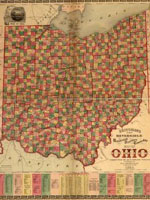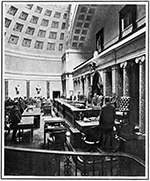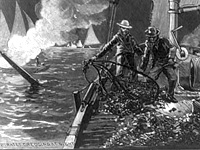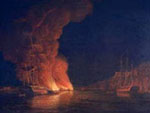
1. To your face, a store-clerk—rather than asking you when he might expect payment for an overdue bill—says that he doubts you have ever intended to pay it. What should your response be?
A. Take out a pistol and threaten to shoot him, unless he immediately apologizes.
B. Ignore the insult as unworthy of notice and take your business elsewhere.
C. Later that day, have your Second ask him for an explanation. If the response conveyed to you is not satisfactory, challenge the clerk to a duel.
D. Immediately beat the clerk with a cane or a horsewhip for his insolence, or have your servant do it.
The point of the duel was not to inflict harm on your opponent, but to preserve your honor. If your honor was threatened and you did not defend it, then you demonstrated that you had none. The clerk was below you in social station and so could not threaten your honor. Duels could only occur between social equals—and gentlemen—who could be expected to rise to a challenge. However, social inferiors could sometimes require discipline or punishment, with the cane or the whip, for their impertinence or rebelliousness.
2. During an evening at a tavern with your long-time acquaintances, the political discussion becomes heated and one of the party intimates strongly but vaguely that the local opposition party leadership (of which you are a member) clings to power because of its willingness to offer bribes. What should you do about it?
A. Nothing at the time and nothing in front of other people. Avoid mentioning it then, but send a respectful letter through a Second to the other person shortly thereafter, asking for an explanation of his actions or words.
B. Call the attention of other witnesses to the insult just after it happens. Leave the scene immediately and send a written challenge to a duel to the person who insulted you.
C. Confront the other person immediately, explaining that he has impugned your honor. Slap his face with a glove or your hand, and tell him that your Second will deliver a demand to him for a duel to settle the matter.
Advocates of the Code of Honor held that its formalities minimized spontaneous escalations of violence, allowing passions to abate and providing opportunities for mediation and reconciliation. Moreover, the Code cautioned against reacting immediately and in front of other people because such an uncontrolled reaction would insult the integrity of the group and would preclude any resolution of the dispute except through a duel. The careful procedures the participants were expected to follow were explicitly detailed. The person who felt insulted and the person whom he thought had insulted him were the "Principals." Each of them found "Seconds," who acted on their behalf at various points in the dispute. The aggrieved Principal was expected to write a polite note to the other Principal (delivered to him by the first Principal's Second), asking for a clarification of his words or actions. If the response did not satisfy the aggrieved Principal, he would write another note, issuing a challenge to a duel, which the Seconds would arrange.
3. You have been sent a note asking for an explanation of your words or actions, but you refuse to respond satisfactorily and repeatedly ignore the challenger's request for an explanation or his later challenge to a duel. What is likely to happen next?
A. You and your friends have a good chuckle over it all and get back to your work, knowing that dueling is unlawful.
B. You send the challenger's note to the local police requesting a judge to issue an injunction against the challenger to stay away from you.
C. The challenger posts a notice in a public place, naming you as a coward who is unwilling to defend his honor. As a consequence, your friends shun you, your business fails, and any political aspirations you may have had are now finished. Your family is shamed by their loss of honor.
The Code of Honor was seen as existing in a society in which the law might act to defend and protect many things, but did not act to defend your personal sense of honor, which could be taken from you if you did not think enough of it to defend it. Dueling was technically illegal in every state in which it was practiced (with the punishment ranging from execution to disbarment from public office), but the law was rarely enforced. Moving the defense of one's honor under the umbrella of the law—through such things as the establishment of libel laws and the use of civil suits—was probably one of the causes of eventually quelling the practice of dueling.
4. You have sent a note, asking for explanation for someone's words that have offended your honor. In a note of reply, the person explains that he was intoxicated when he said what you found offensive. Is that the end of the matter?
A. Yes. Gentlemen may not have been excused by the law from criminal actions that they perpetrated when drunk, but the point of honor with other gentlemen was satisfied when the offender stated that he had been intoxicated.
B. No. In order to satisfy your honor, the offender was obliged, not only to state in reply to you that he was intoxicated, but also to disavow explicitly the insulting words.
Wilson's Code says, "Intoxication is not a full excuse for insult, but it will greatly palliate. If it was a full excuse, it might be well counterfeited to wound feelings, or destroy character." If the initial insult was "You are a liar and no gentleman," the note must not only explain that he was intoxicated when he said that (or that he does not remember saying it because he was intoxicated), but also must state, "I believe the party insulted to be a man of the strictest veracity and a gentleman."
5. Someone strikes you, but then soon apologizes. Is that all that honor demands?
A. Yes. A heartfelt apology, publicly offered, is to be accepted in a spirit of Christian forgiveness. The honor of both parties is preserved.
B. No, that is not enough. Words alone cannot satisfy for a blow offered first.
Wilson's Code says, "As a blow is strictly prohibited under any circumstances among gentlemen, no verbal apology can be received for such an insult; the alternatives therefore are: the offender handing a cane to the injured party, to be used on his own back, at the same time begging pardon; firing on until one or both is disabled; or exchanging three shots, and then asking pardon without the proffer of the cane."
6. Apart from the Principals and their Seconds, who should be present on the ground during a duel?
A. The duelers' families.
B. Members of the local constabulary.
C. The duelers' ministers or priests.
D. Surgeons and their assistants.
E. The general public.
No one else in this list would have been welcome or even tolerated. Dueling was not a family feud, and having family members present would have been distracting, provocative, and cruel. Dueling was conceived as a private matter between gentlemen, so the general public was certainly not invited to witness it. It was also illegal, and so duels were generally conducted in secret, at a time and place such that police or sheriffs would not interfere. And the clergy did not countenance the practice, and so they would not appear on the dueling ground either.
7. If you are the Principal in a duel and you come onto the ground but then refuse to fight or to continue the fight when required—or you leave the site altogether—what should your Second do?
A. Step in and take your place in the duel to uphold your honor.
B. Try to determine from you the reasons for your actions, explain them to the other Principal and Second, and negotiate the best settlement possible.
C. Ask for mercy from the other Principal on your behalf.
D. Say to the other Second: "I have come upon the ground with a coward. I tender you my apology for an ignorance of his character." Then tell him and the other Principal that they may publicly post your name as a coward.
It was felt that if the strongest means to enforce the system were not in place, it would very quickly become nothing but a farce. During antebellum years, the weapons used were often smoothbore, muzzle-loaded, flintlock pistols, which fired a single bullet and had to be reloaded after each shot. The exchange of shots was sometimes lethal, but often not. Depending on the nature of the dispute and the disputants, honor might be "satisfied" on both sides after an exchange of fire in which neither one of the Principals was hit, or in which one or the other were merely wounded or grazed.
8. As Principal, you appear with your Second at the appointed time and place for the duel. The other Principal also appears with his Second and offers you an apology for his insult. Is your honor satisfied?
A. Yes. The whole point is the reconciliation of disputes.
B. No. At this point the dispute cannot be settled with a mere apology, for the other Principal has placed you in a trying situation far beyond the initial insult. The duel must proceed.
"No apology can be received, in any case, after the parties have actually taken their ground, without exchange of fires." In fact, this rule was sometimes breached, and reconciliation was achieved on the ground before shots were exchanged.
9.Is honor satisfied if one or both of the Principals "delopes"—that is, deliberately fires into the air or into the ground to avoid harming each other, or to show their magnanimity?
A. Yes. It is sufficient, and in many cases, laudable.
B. No. This is not admissible.
If the offence and the challenge were not serious in the first place, it should not have come to the point of a duel. If they were serious, the duel must be taken seriously, or in a way that might even suggest that you do not regard your opponent as worthy to shoot at. As a matter of historical fact, however, either one or both of the Principals did "delope" and afterwards counted the matter settled.
10. After an exchange of shots and neither one of the Principals is hit, can the duel be ended with honor served?
A. No, never. The Principals must reload and continue firing until one of them is hit.
B. Yes, always. The exchange of shots proves each Principal's willingness to defend his honor.
C. Yes, sometimes, depending on whether the Challenger feels that his honor has been satisfied.
If neither Principal is hit, the Second to the one who was challenged should approach the Challenger's Second and ask if he is satisfied. He may say yes, if the original insult or injury was not great, but he may say no if the insult was a serious one, in which case the duel must continue until one or the other of the Principals is hit.
 White actor, singer, and dancer, Thomas D. Rice, wrote and performed "Jim Crow" (sometimes called "Jump Jim Crow" because of the first line of the chorus) in 1829 or 1830. To perform the song, Rice dressed in tattered rags and frolicked comically to impersonate a very low caricature of a black man. His performances became an overnight sensation among white audiences, and he performed all over the country. He then took his act to Britain and France, where it became an even bigger hit.
White actor, singer, and dancer, Thomas D. Rice, wrote and performed "Jim Crow" (sometimes called "Jump Jim Crow" because of the first line of the chorus) in 1829 or 1830. To perform the song, Rice dressed in tattered rags and frolicked comically to impersonate a very low caricature of a black man. His performances became an overnight sensation among white audiences, and he performed all over the country. He then took his act to Britain and France, where it became an even bigger hit. Segregated public transportation began in the North before the Civil War. In many parts of the South, a black could not travel at all, unless he or she was accompanying (or accompanied by) a white, or carrying a pass from a white person.
Segregated public transportation began in the North before the Civil War. In many parts of the South, a black could not travel at all, unless he or she was accompanying (or accompanied by) a white, or carrying a pass from a white person. Douglass may not have been the very first, but he appears to have been one of the first. African Americans in New England, beginning in late 1839, along with white abolitionists, with some successes, deliberately challenged extra-legal but fairly common Jim Crow accommodations on railroads, on stagecoaches, in churches ("Negro pews"), and in schools. The persistence of Jim Crow practices in the North, however, gave Southern slave-holding whites the opportunity to reproach even abolitionist Northern whites for "not treating their free blacks better."
Douglass may not have been the very first, but he appears to have been one of the first. African Americans in New England, beginning in late 1839, along with white abolitionists, with some successes, deliberately challenged extra-legal but fairly common Jim Crow accommodations on railroads, on stagecoaches, in churches ("Negro pews"), and in schools. The persistence of Jim Crow practices in the North, however, gave Southern slave-holding whites the opportunity to reproach even abolitionist Northern whites for "not treating their free blacks better." Woodrow Wilson, who had been born in Virginia, soon after he took office in 1913, began a government-wide segregation of blacks and whites in Federal workplaces, restrooms, and lunchrooms. The policy appears to have been instituted after Wilson's Georgia-born wife Ellen visited the Bureau of Printing and Engraving in Washington and "saw white and negro women working side by side." Wilson's Secretary of the Treasury, William McAdoo (also Georgia-born, and soon to be the Wilsons' son-in-law) took the hint. Shortly thereafter, Assistant Secretary of the Treasury John Skelton Williams issued an order segregating the races in the Bureau. A Washington-wide order, covering all Government offices, followed, and soon all Federal offices everywhere in the country were covered by the same order.
Woodrow Wilson, who had been born in Virginia, soon after he took office in 1913, began a government-wide segregation of blacks and whites in Federal workplaces, restrooms, and lunchrooms. The policy appears to have been instituted after Wilson's Georgia-born wife Ellen visited the Bureau of Printing and Engraving in Washington and "saw white and negro women working side by side." Wilson's Secretary of the Treasury, William McAdoo (also Georgia-born, and soon to be the Wilsons' son-in-law) took the hint. Shortly thereafter, Assistant Secretary of the Treasury John Skelton Williams issued an order segregating the races in the Bureau. A Washington-wide order, covering all Government offices, followed, and soon all Federal offices everywhere in the country were covered by the same order.

 For more on major U.S. Supreme Court cases, try a search in our
For more on major U.S. Supreme Court cases, try a search in our 

 Oysters became a high-demand source of protein and nutrition following the Civil War. With the rise of industry and of shipping by rail, canneries and corporate oyster farming operations sprang up on both coasts, eager to supply the working class, and anyone else who wanted the tasty shellfish, with oysters shipped live or canned. In San Francisco, a center of oyster piracy, the boom years of the oyster industry corresponded, unsurprisingly, with those of the oyster industry—both took off in 1870, as the state began allowing major oyster farming operations to purchase the rights to underwater bay "land" (traditionally common property), and petered off in the 1920s, as silt and pollution disrupted the bay's ecosystem.
Oysters became a high-demand source of protein and nutrition following the Civil War. With the rise of industry and of shipping by rail, canneries and corporate oyster farming operations sprang up on both coasts, eager to supply the working class, and anyone else who wanted the tasty shellfish, with oysters shipped live or canned. In San Francisco, a center of oyster piracy, the boom years of the oyster industry corresponded, unsurprisingly, with those of the oyster industry—both took off in 1870, as the state began allowing major oyster farming operations to purchase the rights to underwater bay "land" (traditionally common property), and petered off in the 1920s, as silt and pollution disrupted the bay's ecosystem. At 15, Jack London bought a boat, the Razzle Dazzle, and joined the oyster pirates of San Francisco Bay to escape work as a child laborer. London wrote about his experiences in his semi-fictional autobiography, John Barleycorn, and used them in his early work, The Cruise of the Dazzler, and in his Tales of the Fish Patrol. The latter tells the story of oyster pirates from law enforcement's perspective—after sailing as an oyster pirate, London switched sides himself, to hunt his former compatriots.
At 15, Jack London bought a boat, the Razzle Dazzle, and joined the oyster pirates of San Francisco Bay to escape work as a child laborer. London wrote about his experiences in his semi-fictional autobiography, John Barleycorn, and used them in his early work, The Cruise of the Dazzler, and in his Tales of the Fish Patrol. The latter tells the story of oyster pirates from law enforcement's perspective—after sailing as an oyster pirate, London switched sides himself, to hunt his former compatriots. The working class romanticized oyster pirates as Robin-Hood-like heroes, fighting back against the new big businesses' private control of what had once been common land. Traditionally, underwater "real estate" was commonly owned—anyone with a boat or oyster tongs could fish or dredge without fear of trespassing. Following the Civil War, states began leasing maritime "land" out to private owners; and the public protested, by engaging in oyster piracy, supporting oyster pirates, scavenging in tidal flats and along the boundaries of maritime property, and, occasionally, engaging in armed uprisings.
The working class romanticized oyster pirates as Robin-Hood-like heroes, fighting back against the new big businesses' private control of what had once been common land. Traditionally, underwater "real estate" was commonly owned—anyone with a boat or oyster tongs could fish or dredge without fear of trespassing. Following the Civil War, states began leasing maritime "land" out to private owners; and the public protested, by engaging in oyster piracy, supporting oyster pirates, scavenging in tidal flats and along the boundaries of maritime property, and, occasionally, engaging in armed uprisings.  The opera satirized Governor William Evelyn Cameron's second raid against oyster pirates in the Chesapeake Bay, on February 27, 1883. Cameron had conducted a very successful raid the previous February, capturing seven boats and 46 dredgers, later pardoning most of them to appease public opinion—which saw the pirates as remorseful, hard-working family men. His second raid, in 1883, went poorly. Almost all of the ships he and his crews chased escaped into Maryland waters, including the Dancing Molly, a sloop manned only by its captain's wife and two daughters (the men had been ashore when the governor started pursuit). The public hailed the pirates as heroes and ridiculed the governor in the popular media—the Lynchberg Advance, for instance, ran a
The opera satirized Governor William Evelyn Cameron's second raid against oyster pirates in the Chesapeake Bay, on February 27, 1883. Cameron had conducted a very successful raid the previous February, capturing seven boats and 46 dredgers, later pardoning most of them to appease public opinion—which saw the pirates as remorseful, hard-working family men. His second raid, in 1883, went poorly. Almost all of the ships he and his crews chased escaped into Maryland waters, including the Dancing Molly, a sloop manned only by its captain's wife and two daughters (the men had been ashore when the governor started pursuit). The public hailed the pirates as heroes and ridiculed the governor in the popular media—the Lynchberg Advance, for instance, ran a  Oyster piracy highlights the class tensions that sprang up during post-Civil War industrialization. Big business and private ownership began to drive the economy, shaping the lives of the working class and changing long-established institutions and daily patterns. Young people such as Jack London turned to oyster piracy as an escape from the new factory work—and the working class chaffed against the loss of traditional maritime common lands to business owners.
Oyster piracy highlights the class tensions that sprang up during post-Civil War industrialization. Big business and private ownership began to drive the economy, shaping the lives of the working class and changing long-established institutions and daily patterns. Young people such as Jack London turned to oyster piracy as an escape from the new factory work—and the working class chaffed against the loss of traditional maritime common lands to business owners.





 The map of the 1920 concentration of manufacturing establishments was generated by the University of Virginia Library's
The map of the 1920 concentration of manufacturing establishments was generated by the University of Virginia Library's 

 On June 15, 1904, the General Slocum departed on the annual Sunday School excursion of St. Mark's German Lutheran Church. However, unbeknownst to passengers and crew, a fire had broken out in a storage room. Many passengers died of burns, and others drowned, unable to swim. The steamer's defective life preservers added to the death toll. The preservers' insides, made of finely-ground cork, quickly became waterlogged when the preservers' rotten covers fell away. One survivor told of a woman with three children. The mother and two girls could swim, but one daughter could not. The daughter was put in a life preserver and tossed overboard, where she immediately sank.
On June 15, 1904, the General Slocum departed on the annual Sunday School excursion of St. Mark's German Lutheran Church. However, unbeknownst to passengers and crew, a fire had broken out in a storage room. Many passengers died of burns, and others drowned, unable to swim. The steamer's defective life preservers added to the death toll. The preservers' insides, made of finely-ground cork, quickly became waterlogged when the preservers' rotten covers fell away. One survivor told of a woman with three children. The mother and two girls could swim, but one daughter could not. The daughter was put in a life preserver and tossed overboard, where she immediately sank. If you are curious about the Mary Celeste, one interesting online resource is "
If you are curious about the Mary Celeste, one interesting online resource is "

